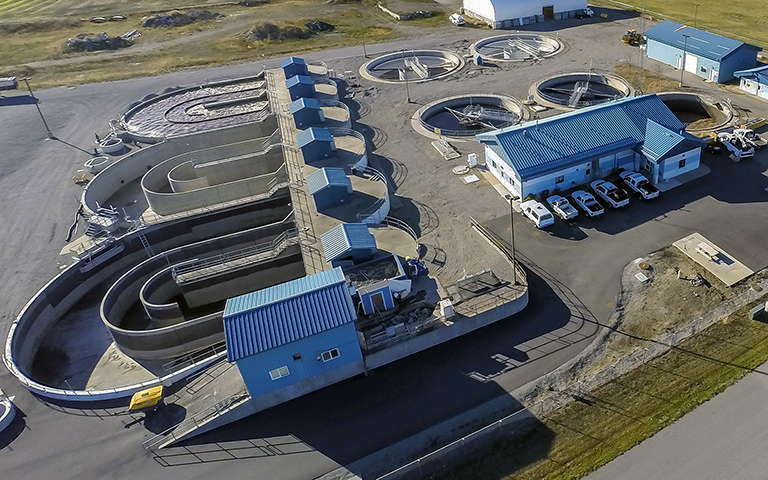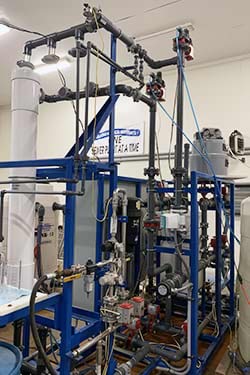Ultra-Low Phosphorus With Integrated Tertiary Treatment
Solids Contact Clarification and Ultrafiltration Achieve <0.035 mg/L TP

Overview
The Hayden Area Regional Sewer Board (HARSB) wastewater treatment plant (WWTP) process consists of headworks, equalization, biological nutrient removal, oxidation ditches, and secondary clarification. At the facility, enhanced biological phosphorus removal (EBPR) is used to produce a treated discharge with typical total phosphorus (TP) concentrations in the range of <1.0 mg/L as P. However, during upset conditions of the EBPR process, discharge concentrations can often increase to values of >8 mg/L TP.
In 2022, the WWTP is subject to a more stringent National Pollutant Discharge Elimination System (NPDES) permit standard, which correlates to a new target discharge value equivalent to 0.035 mg/L TP. Various physico-chemical based unit processes, including tertiary clarification and membrane filtration, were considered to meet these requirements. The selected integrated tertiary treatment (ITT) system process includes 3.45 MGD solids contact clarification (SCC) and 2.4 MGD ultrafiltration systems, plus multi-point chemical dosing of ferric chloride (FeCl3 ) to account for large variation in influent phosphorus concentration. A unique collaborative design approach between owner, engineer, and WesTech was also selected to consolidate process responsibility and streamline scope of supply.
The SCC is a combination treatment unit that achieves low shear mixing for flocculation followed by gravity sedimentation for clarification within a single tank. A notable feature of this process is the use of internal solids recirculation for increased efficiency and reduced overall footprint. Following the SCC, low-pressure ultrafiltration (UF) is used as a finishing/polishing step to remove particulate phosphorus and suspended solids. For this, a low-fouling polyvinylidene fluoride (PVDF), dead-end, outside-in hollow fiber membrane was used. This technology is able to consistently remove particulate matter using an absolute barrier filtration method and a 0.01 µm nominal pore size.

An 18-week demonstration pilot was used to verify phosphorus removal by SCC and UF, with FeCl3 addition under a wide range of influent phosphorus conditions. Additional scenarios were also tested to evaluate the impact of pretreatment on membrane filtration system operation, as well as overall phosphorus reduction. These included SCC upset conditions, UF without SCC pretreatment, and varied chemical dosing. Notably, this pilot demonstrated that the targeted effluent phosphorus concentration of 0.035 mg/L as P was achievable under all feed conditions, including total phosphorus >8.0 mg/L TP. Final average filtrate phosphorus values were achieved with and without SCC pretreatment as 0.018 mg/L TP and 0.024 mg/L TP, respectively.
Operational performance was used to verify full-scale system design parameters. The UF system demonstrated stable transmembrane pressure, with and without pretreatment, at the design flux rate of 33.3 gfd with no fiber breakages. However, the benefits of the SCC system included the ability to accommodate more significant process upsets, reduced chemical cleaning requirements, and increased overall UF recovery. With SCC pretreatment, the UF system operated consistently above 95 percent recovery with >30 day chemical clean-in-place frequency.
In addition to technology validation, full-scale equipment design concepts were considered like future expansion, interconnecting piping supply, and a non-proprietary open-platform configuration.
Accordingly, an integrated system approach with WesTech SCC and UF process technologies offers a flexible and robust solution with consolidated process responsibility to consistently achieve ultra-low limit phosphorus targets.
Highlights
- Complete, integrated system with collaborative design
- Highly variable feed, up to 8.44 mg/L TP
- <0.018 mg/L TP average filtrate phosphorus
- >95% UF recovery with >30 day clean-in-place frequency
| SCC HLR range | 0.4 - 0.7 gpm/ft2 |
|---|---|
| Instantaneous flux | 33.3 gfd |
| Feed phosphorus range | 0.5 - 8.44 mg/L as P |
| Target filtrate phosphorus | 0.035 mg/L as P |
| Average filtrate phosphorus (with SCC) | 0.018 mg/L as P |


